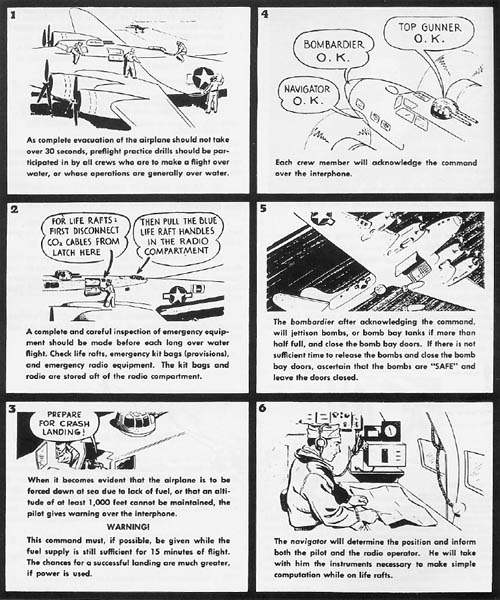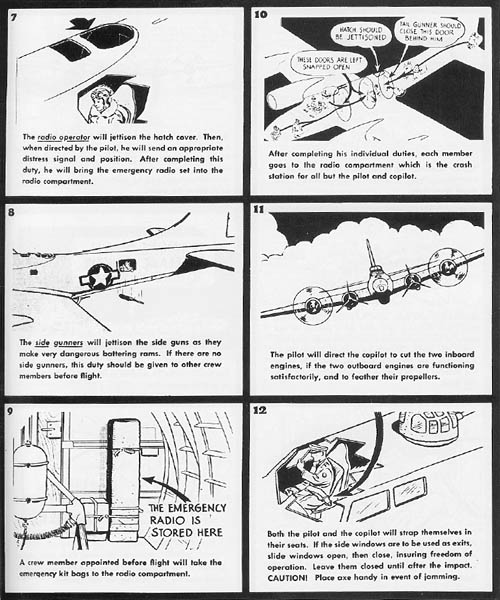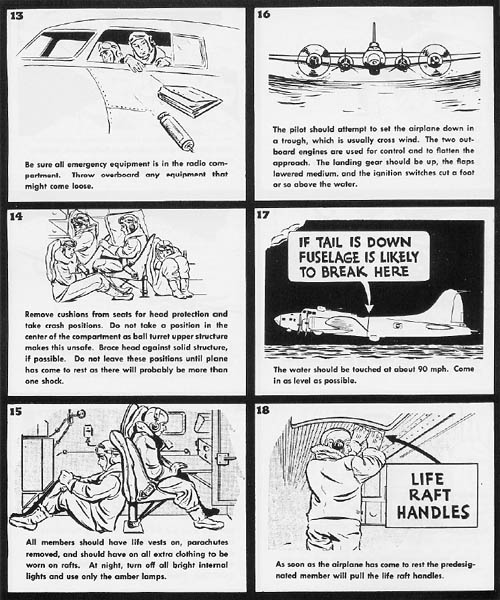Emergency procedures for a forced landing at sea from the Pilot’s Manual for Boeing B-17 Flying Fortress:
FORCED DESCENT AT SEA
1. As complete evacuation of the airplane should not take over 30 seconds, preflight practice drills should be participated in by all crews who are to make a flight over water, or whose operations are generally over water.
2. A complete and careful inspection of emergency equipment should be made before each long over water flight. Check life rafts, emergency kit bags (provisions), and emergency radio equipment. The kit bags and radio are stored aft of the radio compartment.
3. When it becomes evident that the airplane is to be forced down at sea due to lack of fuel, or that an altitude of at least 1,000 feet cannot be maintained, the pilot gives warning over the interphone. WARNING! This command must, if possible, be given while the fuel supply is still sufficient for 15 minutes of flight. The chances for a successful landing are much greater, if power is used.
4. Each crew member will acknowledge the command over the interphone.
5. The bombardier after acknowledging the command, will jettison bombs, or bomb bay tanks if more than half full, and close the bomb bay doors. If there is not sufficient time to release the bombs and close the bomb bay doors, ascertain that the bombs are “SAFE” and leave the doors closed.
6. The navigator will determine the position and inform both the pilot and the radio operator. He will take with him the instruments necessary to make simple computation while on life rafts.
7. The radio operator will jettison the hatch cover. Then, when directed by the pilot, he will send an appropriate distress signal and position. After completing this duty, he will bring the emergency radio set into the radio compartment.
8. The side gunners will jettison the side guns as they make very dangerous battering rams. If there are no side gunners, this duty should be given to other crew members before flight.
9. A crew member appointed before flight will take the emergency kit bags to the radio compartment.
10. After completing his individual duties, each member goes to the radio compartment which is the crash station for all but the pilot and copilot.
11. The pilot will direct the copilot to cut the two inboard engines, if the two outboard engines are functioning satisfactorily, and to feather their propellers.
12. Both the pilot and the copilot will strap themselves in their seats. If the side windows are to be used as exits, slide windows open, then close, insuring freedom of operation. Leave them closed until after the impact. CAUTION! Place axe handy in event of jamming.
13. Be sure all emergency equipment is in the radio compartment. Throw overboard any equipment that might come loose.
14. Remove cushions from seats for head protection and take crash positions. Do not take a position in the center of the compartment as ball turret upper structure makes this unsafe. Brace head against solid structure, if possible. Do not leave these positions until plane has come to rest as there will probably be more than one shock.
15. All members should have life vests on, parachutes removed, and should have on all extra clothing to be worn on rafts. At night, turn off all bright internal lights and use only the amber lamps.
16. The pilot should attempt to set the airplane down in a trough, which is usually cross wind. The two outboard engines are used for control and to flatten the approach. The landing gear should be up, the flaps lowered medium, and the ignition switches cut a foot or so above the water.
17. The water should be touched at about 90 mph. Come in as level as possible.
18. As soon as the airplane has come to rest the predesignated member will pull the life raft handles.













Makes ditching a heavy bomber in the ocean look like a piece of cake.
Thanks! I’ve been looking all over the web for this.
After reading this I thought it was very informative. I appreciate you taking the time to put this webpage piece together.
Very nice article. I plan to bookmark this blog.
Hello there. I normally don’t comment on blogs, but I decided to today to thank you for the information I was looking for (via your blog). Thanks again!
Trained for this but never had to do it Richard King
I just StumbledUpon this. Not so bad. I will give it a thumbs up.
Hey excellent writeup here. keep it going.